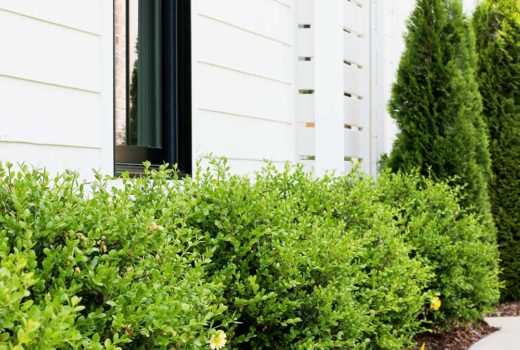
If you don’t want to take the time to plant grass seed, your other option is to lay sod. We did this recently around our pool and it turned out even better than we hoped! Here are some instructions on how to lay sod so you can get that instant green lawn you’ve always dreamed of.
Sod comes in rolls allowing for easy installation. On the top of the sod, you’ll see the grass blades and on the bottom, you’ll see the grass roots and some dirt.

Laying sod means that you’re placing the sod rolls on top of the ground so that the grass roots on the sod will grow into the ground of your lawn.
Preparing Your Ground for Sod
Preparing your ground to accept the new sod is where the bulk of the work comes in. This will ensure that your sod will take root and continue to grow. Here are some tips for preparing your ground before you lay sod.

- Pick the right time of year. If you’re working with cool-season grass you’ll need to lay the sod in late summer or early fall. If you’re using warm-season grass you can plant at any time of year.
- Take a soil test. It’s important that your sod has the nutrients it needs to grow. This means that before you even plant the sod, you may need to add some much-needed nutrients. You can find out what you need to add by testing your soil by sending your soil to your local extension office to find out what you got and what you need. You’re looking for a good soil pH of 6.0 to 7.5.
- Remove any grass. You’ll want to start laying your sod on bare ground. Get rid of any grass or weeds before starting.
- Break up the dirt. Break up the dirt where the sod is going to lay with a shovel or a rake. Even better if you have access to a rototiller and can till 4-6 inches down.
- Fertilize and condition. Add a starter fertilizer and a soil conditioner. Work them into the ground before starting.
- Add topsoil if needed. If you’d like to add topsoil do so at this point. Don’t add more than 1 ½ inches of the topsoil.
- Give it a final rake. Get rid of any big chunks of dirt by giving the dirt a final rake. Get the soil nice and even but be sure not to compact the dirt as you’re raking. The ground should be 1 inch under any patios, sidewalks, or sprinkler heads.
Laying the Sod
Now that you have the ground prepared, you’re ready to start laying the sod. When the sod arrives keep it in a shady cool place if possible. It’s important that your sod be planted and watered as soon as possible. This is definitely a project you’ll want to get done in one day.

- Dampen the sod with your garden hose.
- Unroll your first roll of sod starting on the edge of the area. If you need to use more than one roll, place the two rolls end to end. Use your hands to butt them against each other tightly but make sure they aren’t overlapping. Continue to lay sod until the first edge of the area is filled.
- Go to the opposite edge and fill that edge in with sod. You’re working on the outer edges first before you move into the center.
- Don’t step on the sod as you’re installing it. Lay it out in front of you and step back onto the bare ground.
- As you fill in the adjacent rows with sod, make sure that the end and beginning of the sod rolls don’t line up with other ends in the surrounding rows. Stagger the sod like bricks to get a more natural look.
- If you find a piece of sod that sits lower than the others, simply add some topsoil underneath.
- Neaten the edges by using a sharp knife or box cutter if needed. Keep in mind that it’s better to trim in the center of the area than around the edges.
- Roll the entire area that you laid sod with a lawn roller. This will help the roots of the sod make contact with the ground and it will get rid of any air pockets.
- Water the new sod within 30 minutes of installation. This may mean that you take breaks to water as you’re laying the sod.
Caring for Your New Sod
Watering your new sod is important in establishing the roots. You’ll want to water every day for the first few weeks for this to happen. You can estimate 1 inch of water a week in the cooler months and 2 inches during the summer.
If you’re afraid of overwatering, take off a small piece of sod and look at the bottom. It should be damp without being muddy.
Once the grass starts to grow you can start mowing. Mow it high at first and then you can gradually cut it lower as time goes on.
How Much Does Sod Cost?
On average, sod costs $.30 to $.85 per square foot depending on where you are and what type of grass you want. This doesn’t include the labor, because you’ll be doing that yourself.
Here’s a sod calculator so you can find how much sod you need and how much it’s going to cost you.





No Comments